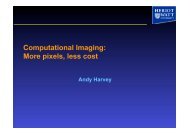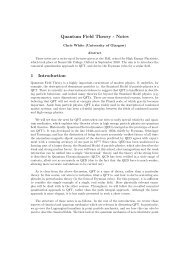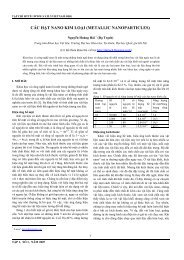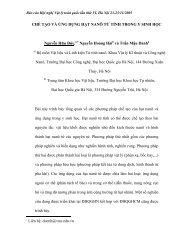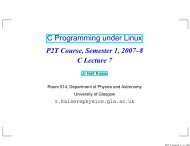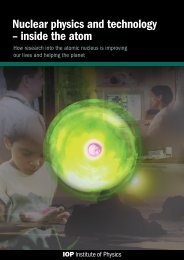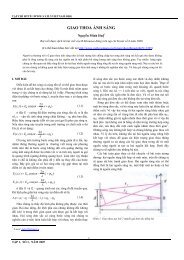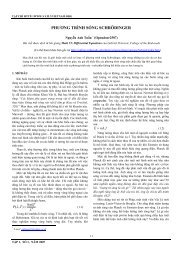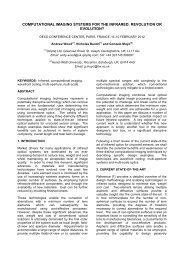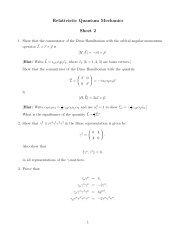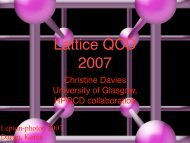pdf of text - University of Glasgow
pdf of text - University of Glasgow
pdf of text - University of Glasgow
You also want an ePaper? Increase the reach of your titles
YUMPU automatically turns print PDFs into web optimized ePapers that Google loves.
Gravitational Wave – GRB ConnectionsJim HoughSUPA, Department <strong>of</strong> Physics and Astronomy, <strong>University</strong> <strong>of</strong> <strong>Glasgow</strong>, <strong>Glasgow</strong> G12 8QQ, UKFor the LIGO Scientific CollaborationKeywords: gravitational waves; laser interferometer; GRBs; LIGO; GEO 600AbstractAfter 35 years <strong>of</strong> experimental research we are rapidly approaching the point at whichgravitational waves from astrophysical sources may be directly detected by the longbaselinedetectors LIGO (USA), GEO 600 (Germany/UK), VIRGO (Italy/France) andTAMA 300 (Japan) which are now in or coming into operation.A promising source <strong>of</strong> gravitational waves is the coalescence <strong>of</strong> compact binary systems,events which are now believed to be the origin <strong>of</strong> short gamma ray bursts.In this paper a brief review <strong>of</strong> the state <strong>of</strong> the art in detector development and exploitationwill be given, with particular relevance to a search for signals associated with gamma raybursts, and plans for the future will be discussed.1
1. IntroductionFor many years there has been controversy over research into the existence <strong>of</strong> gravitationalwaves. Indeed several early relativists were sceptical about their existence. However the field hasbeen recognized by the 1993 Nobel Prize in Physics being awarded to Hulse and Taylor for theirexperimental observations and subsequent interpretations <strong>of</strong> the evolution <strong>of</strong> the orbit <strong>of</strong> thebinary pulsar PSR 1913+16, the decay <strong>of</strong> the binary orbit being consistent with angularmomentum and energy being carried away from this system by gravitational waves [1]. Further,long baseline detectors with a sensitivity sufficient to allow some possibility for the detection <strong>of</strong>astrophysical sources, including gravitational wave signals associated with gamma-ray bursts(GRBs) and s<strong>of</strong>t gamma-ray repeaters (SGRs), - LIGO, VIRGO, GEO 600 and TAMA 300 - arenow coming into operation [2-5].These detectors use laser interferometry for motion sensing over km scale distances.2. Gravitational WavesGravitational waves, predicted in General Relativity to be produced by the acceleration <strong>of</strong> mass[6], are propagating strains in space that in their simplest form lead to tiny quadrupoledeformations <strong>of</strong> mechanical systems with which they interact. The strain (δl/l), between objects adistance l apart, is represented by the gravitational wave amplitude (h) where h = 2 δl/l. Forquadrupole radiation there are two orthogonal polarizations <strong>of</strong> the wave at 45 degrees to eachother, <strong>of</strong> amplitude h + and h x and each <strong>of</strong> these is equal to twice the strain in space in the relevantdirection. Thus a Michelson interferometer formed between freely hanging mirrors might undergoa differential change in its arm lengths.Because <strong>of</strong> the very weak nature <strong>of</strong> gravity and lack <strong>of</strong> dipole radiation, the efficiency <strong>of</strong>converting mechanical energy in a system into gravitational radiation is very low and thus signalsproduced by accelerating systems tend to be very weak. Indeed the only sources <strong>of</strong> gravitationalwaves (GWs) that are likely to be detected are astrophysical, where there are potentially hugemasses accelerating very strongly. Thus gravitational wave detectors will uncover dark secrets <strong>of</strong>the Universe by helping us to study sources in extreme physical conditions: strong non-lineargravity and relativistic motion, extremely high density, temperature and magnetic fields, to list afew. Gravitational wave signals are expected over a wide range <strong>of</strong> frequencies, from 10 -17 Hz inthe case <strong>of</strong> ripples in the cosmological background to 10 3 Hz or greater. These higher frequencysignals can originate from a number <strong>of</strong> sources e.g. when compact neutron star or black holebinaries coalesce (believed to have short GRBs associations [7]) or in the collapse resulting fromsupernova explosions (believed to have long timescale GRB associations [8]) or when quakestake place in the crusts <strong>of</strong> neutron stars as may be associated with SGRs. For a recent review <strong>of</strong> arange <strong>of</strong> gravitational wave sources see [9] and references therein. It is important to note thatpredicted strains in space at the earth are typically <strong>of</strong> the order <strong>of</strong> 10 -21 or smaller.3. Long baseline interferometric detectors on earthThis idea <strong>of</strong> using laser interferometry between freely suspended test masses was proposed in1962 [10] but for implementation had been awaiting the availability <strong>of</strong> relevant laser and opticaltechnology. Indeed Robert Forward (a former student <strong>of</strong> Weber) built the first laserinterferometric prototype in the early 1970s at the Hughes Aircraft Laboratories in Malibu,although the sensitivity was limited by the short distance between the masses and the low power<strong>of</strong> the helium neon laser used [11]. The concept is very attractive in that it <strong>of</strong>fers the possibility <strong>of</strong>2
very high sensitivities over a wide range <strong>of</strong> frequency [12].Figure 1. Schematic diagram <strong>of</strong> how gravitational waves interact with a ring <strong>of</strong> matter. The ‘quadrupole’nature <strong>of</strong> the interaction can be clearly seen, and if the mirrors <strong>of</strong> the Michelson Interferometer on the rightlie on the ring with the beamsplitter in the middle, the relative lengths <strong>of</strong> the two arms will change and thusthere will be a changing interference pattern at the output.This technique is based on the Michelson interferometer and is particularly suited to thedetection <strong>of</strong> gravitational waves as they have a quadrupole nature (figure 1). Waves propagatingperpendicular to the plane <strong>of</strong> the interferometer will result in one arm <strong>of</strong> the interferometer beingincreased in length while the other arm is decreased and vice versa. The induced change in thelength <strong>of</strong> the interferometer arms results in a small change in the intensity <strong>of</strong> the light observed atthe interferometer output.With the increasing availability <strong>of</strong> argon-ion lasers and then neodymium YAG lasers withthe capability <strong>of</strong> producing watts <strong>of</strong> single frequency light a number <strong>of</strong> prototype detectors wereconstructed around the world - see [13] for more discussion on this - leading to the funding andbuilding <strong>of</strong> the current generation <strong>of</strong> long baseline instruments – LIGO, VIRGO, GEO 600 andTAMA 300 [2-5] - which will be described in a later section.In order to observe a full range <strong>of</strong> sources and initiate gravitational wave astronomy asensitivity or noise performance in strain <strong>of</strong> below 10 -23 /√Hz has to be achieved over most <strong>of</strong> theproposed operating range from 10 Hz to a few kHz. For an Earth-based detector the distancebetween the test masses is limited to a few km by geographical and cost factors. If we assume anarm length <strong>of</strong> 3 to 4 km, detecting a strain in space <strong>of</strong> the above level implies measuring aresidual motion <strong>of</strong> each <strong>of</strong> the test masses <strong>of</strong> around 10 -20 m/√Hz. This sets a formidable butachievable goal for both the fine mechanics and the optical detection system <strong>of</strong> theinterferometer.3.1. Current situation with interferometric detectorsThe American LIGO project comprises two detector systems with arms <strong>of</strong> 4 km length, one inHanford, Washington State, and one in Livingston, Louisiana. One half length, 2 km,interferometer has also been built inside the same evacuated enclosure at Hanford [2]. A birdseyeview <strong>of</strong> the Hanford site showing the central building and the directions <strong>of</strong> the two arms isshown in figure 2. Construction <strong>of</strong> LIGO began in 1996 and progress has been outstanding with3
the instruments currently [September 2006] being at design sensitivity.Figure 2. Schematic diagram and birds eye view <strong>of</strong> LIGO (Hanford), with current strain sensitivity curvesImages and figure courtesy <strong>of</strong> the LIGO Scientific CollaborationThe French/Italian VIRGO detector <strong>of</strong> 3 km arm length at Cascina near Pisa is designedto have similar minimum sensitivity but a better performance at lower frequencies, down to 10Hz, and is coming into operation [3]. The Japanese TAMA 300 detector, which has arms <strong>of</strong>length 300 m, is operating at the Tokyo Astronomical Observatory [5].4
All the systems mentioned above are designed to use resonant cavities in the arms <strong>of</strong> thedetectors to enhance their response and use simple wire sling techniques for suspending the testmasses. However the German/British detector, GEO 600, is somewhat different [4]. It makes use<strong>of</strong> a four-pass-delay-line system with a novel optical technique known as signal recycling [14],and utilises fused silica suspensions <strong>of</strong> very low mechanical loss for the test masses to helpreduce thermal noise [15]. GEO is reaching a sensitivity at frequencies above a few hundred Hzaproaching that <strong>of</strong> LIGO. GEO is now fully built and its sensitivity is being continuouslyimproved. Currently it is within a factor <strong>of</strong> ~ 3 <strong>of</strong> its broadband design sensitivity over much <strong>of</strong>its frequency range.Four science runs, ranging from 17 to 70 days in length, have so far been carried out withthese new interferometric detectors, and a fifth has currently been underway for nearly a year. Allhave involved the LIGO detectors, and the GEO detector was involved in three <strong>of</strong> the first fourdata runs and has been operating fully in the fifth data run for the past five months. From theearlier science runs, upper limit results on the signals from a number <strong>of</strong> potential sources such aspulsars, coalescing compact binary stars, as well as on burst events and the level <strong>of</strong> a stochasticbackground, have been set [16-19] and a limit on the gravitational wave flux associated withGRB030329 has been set [20]. It should be noted that there had been early searches forcorrelations between gamma ray bursts and gravitational wave bursts using low temperature bardetectors – see [20] and [21] for example.During the period <strong>of</strong> the first four science runs there has been a search with the LIGOdetectors for short duration gravitational wave bursts coincident with 39 gamma ray bursts [22].Triggers for the GRBs were provided by the GCN and IPN networks and searches were carriedout over a time interval <strong>of</strong> 120 secs before the reported burst (to allow for delays in the em signal)and 60 secs after. Waveforms <strong>of</strong> the gravitational wave bursts potentially associated with theGRBs were not known and thus cross-correlation <strong>of</strong> the signals from two LIGO interferometerswere used to look for enhanced correlations over timescales <strong>of</strong> 25 and 100 ms, signal bandwidthbeing from 40 Hz to 2 kHz. Using this sample there was no evidence for coincident gravitationalwave bursts and the best level <strong>of</strong> strain sensitivity set was approximately 7 x 10 -22 for circularlypolarized gravitational waves.The search has continued during the fifth science run. In this case there were 53 GRBtriggers in the first five months <strong>of</strong> the run, 6 <strong>of</strong> these being associated with short GRBs. Again, inthe case where there was at least coverage by two detectors, no events outside <strong>of</strong> the expectedstatistics have been observed [22]. Also it should be noted that a more targeted search for signalsassociated with short GRBs using template techniques for searching for binary coalescencesignals is also underway [23}.A search for quasi-periodic oscillations following the SGR 1806-20 hyperflare has alsobeen carried out with a bound on the gravitational wave strain set at the LIGO Hanford detector[24]. This corresponds to a characteristic isotropic energy release at the source <strong>of</strong> the order <strong>of</strong> 10 -8solar masses for the 100Hz frequency region, where the predicted QPO frequencies and LIGO’sbest sensitivity match. The previous search carried out with the Auriga detector [25] reported alimit <strong>of</strong> the order <strong>of</strong> 10 -6 solar masses for the 900 Hz frequency region where this detector issensitive. Analyses <strong>of</strong> the LIGO data for more recent flares (SGR 1900+14 and SGR 1806-20)are being carried out. Further discussion <strong>of</strong> the detection <strong>of</strong> gravitational waves from SGRs, asdiscussed in a poster at this meeting, can be found at [26].3.2 The next stepsDuring the next few years we can expect to see a series <strong>of</strong> increasingly sensitive searchesfor gravitational wave signals at a sensitivity level <strong>of</strong> approximately 10 -21 for millisecond pulsesor close to 10 -26 for pulsars, to take two examples. This latter level is equivalent to a neutron starhaving an ellipticity <strong>of</strong> ~ 10 -8 and is astrophysically feasible. Thus the detection <strong>of</strong> gravitational5
waves from pulsars in the near term is a real possibility. Further, the recent discovery <strong>of</strong> anothercompact binary system in the galaxy - the double pulsar J0737-3039 - has improved the statisticsfor the expected rate <strong>of</strong> binary coalescences by a significant factor, implying that the mostprobable rate <strong>of</strong> binary neutron star coalescences detectable by the current LIGO system now liesbetween one per 10 years and 1 per six hundred years [27]. Many people expect the rate <strong>of</strong> blackhole/neutron star (and black-hole/black-hole coalescences to be significantly higher. This is <strong>of</strong>particular significance for the potential detection <strong>of</strong> signals associated with short GRBs.Since detection at the level <strong>of</strong> sensitivity <strong>of</strong> the initial detectors is no way guaranteed,some enhancement <strong>of</strong> performance by increasing laser power and improving the opticaland suspension systems is envisaged over the next few years and may well yield excitingreturns. But improvement <strong>of</strong> the order <strong>of</strong> a factor <strong>of</strong> 10 to 15 in sensitivity <strong>of</strong> the currentinterferometric detectors is essential to allow compact binary coalescences to be detectedat a useful rate. Plans for a significantly rebuilt LIGO, “Advanced LIGO”, are alreadymature and the project has been approved by the National Science Board in the USAfunding being expected to start in financial year 2008. The proposed design for AdvancedLIGO has 40 kg silica test masses, suspended by fused silica fibers (as used in GEO 600)or ribbons, along with an improved seismic isolation system, increased laser power, ~200 W, and signal recycling [28]. The upgrade is now expected to commence in 2010 andit is exciting to note that the most probable rate <strong>of</strong> detectable binary neutron starcoalescences is now expected to be in the range <strong>of</strong> 10 to 500 per year [27]. The noiseanatomy for Advanced LIGO is shown in figure 3. Similar plans for upgrading VIRGOon essentially the same timescale are under development. Further a proposal andunderpinning research is well advanced for an underground detector (LCGT) with cooledtest masses to be built in Japan [29]. There is also a significant effort to find funding toexpand an 80 m interferometer – currently used for technological developments - inWestern Australia to kilometer scale.For GEO a different upgrade strategy is being adopted. A proposed upgrade willbe targeted at the observation <strong>of</strong> the oscillations <strong>of</strong> neutron stars resulting from quakes inpulsars or magnetars, possibly associated with SGRs, and detector improvement will bein the area <strong>of</strong> enhancing narrow-band sensitivity around a few kHz [30].6
Figure 3. Sensitivity curve, showing noise anatomy, for the planned Advanced LIGO detectorsystem.4. The FutureThe next stage forward in interferometric detectors is well defined with the proposedupgrades in the US and Europe, and proposals for new detectors in Japan and Australia and wecan see a really exciting future ahead as fundamentally new information about many violentastrophysical events including gamma ray bursts and s<strong>of</strong>t gamma ray repeaters is uncovered.6. AcknowledgmentsThe author gratefully acknowledges the support <strong>of</strong> the United States NationalScience Foundation for the construction and operation <strong>of</strong> the LIGO Laboratoryand the Particle Physics and Astronomy Research Council <strong>of</strong> the United Kingdom,the Max-Planck-Society and the State <strong>of</strong> Niedersachsen/Germany for support <strong>of</strong>the construction and operation <strong>of</strong> the GEO600 detector. The authors alsogratefully acknowledge the support <strong>of</strong> the research by these agencies and by theAustralian Research Council, the Natural Sciences and Engineering ResearchCouncil <strong>of</strong> Canada, the Council <strong>of</strong> Scientific and Industrial Research <strong>of</strong> India,the Department <strong>of</strong> Science and Technology <strong>of</strong> India, the Spanish Ministerio deEducacion y Ciencia, The National Aeronautics and Space Administration,the John Simon Guggenheim Foundation, the Alexander von Humboldt Foundation,the Leverhulme Trust, the David and Lucile Packard Foundation,the Research Corporation, and the Alfred P. Sloan Foundation. Thanks are also due to the GCNand IPN networks, and to Columbia <strong>University</strong> in the City <strong>of</strong> New York and the <strong>University</strong> <strong>of</strong><strong>Glasgow</strong>, UK..7
7. References1. Hulse R A (1994) Rev. Mod. Phys. 66 699; Taylor J H (1994) Rev. Mod. Phys. 66 7112. Waldman S. J (for the the LIGO Science Collaboration) (2006) Class. Quantum Grav. 23 S653–S6603. Acernese F et al Class. Quantum Grav. 23 (2006) S63–S694. Hild S (for the LIGO Scientific Collaboration) Class. Quantum Grav. 23 (2006) S643–S6515. Takahashi R et al (2004) Class. Quantum Grav. 21 S4036. Einstein A (1916) Koeniglich Preussiche Akademie der Wissenshaften Berlin, Sitzungsberichte,Erster Halbband 6887. Eichler D et al (1989) Nature 340 126 ; Paczynski B (1991) Acta Astron. 41 2578. Woosley S E Astrophys. Journal (1993) 405 2739. Grishchuk L (2004) Astrophysics Update Ed. Mason J (Berlin: Springer-Verlag) 28110. Gertsenshtein M E and Pustovoit V I (1962) Sov. Phys. – JETP 16 43311. Moss G E, Miller L R and Forward R.L (1971) Appl. Opt. 10 2495b12. Weiss R (1972) “Electromagnetically Coupled Broadband Gravitational Antenna” (Res. Lab.Electron. MIT Cambridge, US) Progress Report 10513. Hough J, Rowan S and Sathyaprakash B, (2005) Journal <strong>of</strong> Physics B; Atomic and MolecularPhysics 38 S49714. Meers B J (1988) Phys. Rev. D 38 2317; Strain K A and Meers B J (1991) Phys. Rev. Lett. 661391; Grote H et al (2004) Class. Quantum Grav. 21 S47315. Strain K A et al (2004) in Gravitational wave and particle astrophysics detectors, Eds Hough Jand Sanders G H, Proceedings <strong>of</strong> SPIE Vol 5500 (SPIE, Bellingham, WA) 25; Rowan S, Hough Jand Crooks D R M (2005) Phys. Lett. A 347 2516. Abbott B et al. (LSC) (2005) Phys. Rev. Lett. 94, 18110317. Abbott B et al. (LSC) (2006) Phys. Rev. D 73, 10200218. Abbott B et al. (LSC) (2006) Class. Quantum Grav. 23, S29-S3919. Abbott B et al. (LSC) (2005) Phys. Rev. Lett. 95, 22110120. Abbott B et al. (LSC) (2005) Phys. Rev. D 72, 04200221. Tricarico P, Ortolan A, and Fortini P (2003) Class. Quantum Grav. 20 352322. Leonor I (LSC) (2006) talk at APS meeting April 200623. Dietz A (LSC) (2006) in preparation24. Matone L (LSC) (2006) talk at APS meeting April 200625. Baggio L et al (2005) Phys. Rev. Lett. 95 08110326. Clark J et al (2006) http://www.astro.gla.ac.uk/users/jclark/RS/27. Kalogera V et al (2004) Astrophys. J. 601 L179 or arXiv:astro-ph/0312101v328. Fritschel P (2001) LIGO document number T010075-00-D available athttp://www.ligo.caltech.edu/docs/ T010075-00.<strong>pdf</strong>29. Kuroda Kazuaki; the LCGT Collaboration (2006) Class. Quantum Grav. 23 S21530. Willke et al (2006) Class. Quantum Grav. 23, S20-S2148



